Financial Ratio Analysis Example
VerifiedAdded on 2020/01/28
|14
|4634
|120
Report
AI Summary
This assignment presents an example of financial ratio analysis for a company. It covers various categories of ratios including profitability (e.g., gross profit margin, net profit margin), liquidity (e.g., current ratio, quick ratio), solvency (e.g., debt-to-equity ratio), and efficiency (e.g., fixed asset turnover, inventory turnover). The analysis utilizes financial data provided in the document to calculate and interpret these ratios, providing insights into the company's financial health and performance.
Contribute Materials
Your contribution can guide someone’s learning journey. Share your
documents today.
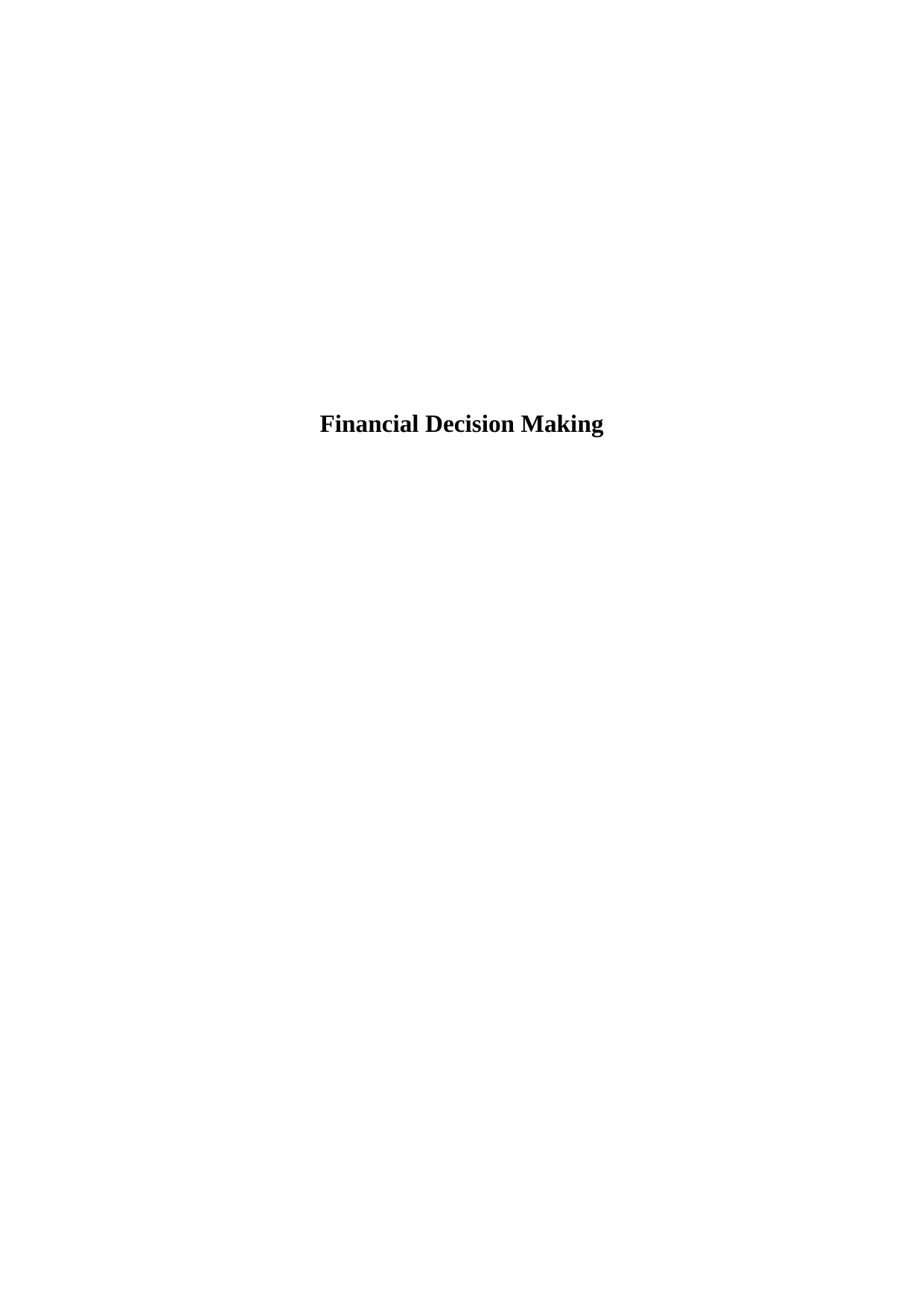
Financial Decision Making
Secure Best Marks with AI Grader
Need help grading? Try our AI Grader for instant feedback on your assignments.
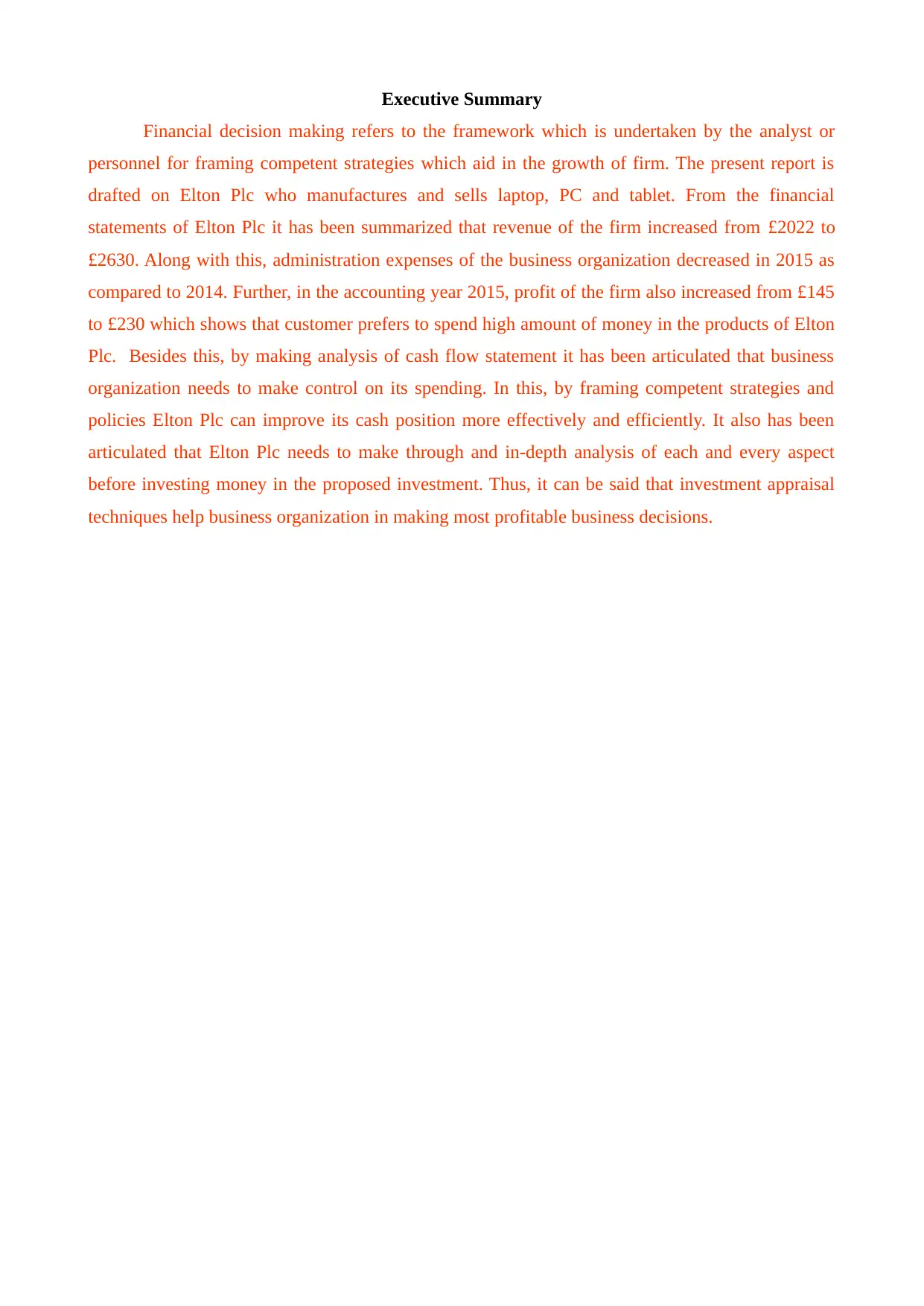
Executive Summary
Financial decision making refers to the framework which is undertaken by the analyst or
personnel for framing competent strategies which aid in the growth of firm. The present report is
drafted on Elton Plc who manufactures and sells laptop, PC and tablet. From the financial
statements of Elton Plc it has been summarized that revenue of the firm increased from £2022 to
£2630. Along with this, administration expenses of the business organization decreased in 2015 as
compared to 2014. Further, in the accounting year 2015, profit of the firm also increased from £145
to £230 which shows that customer prefers to spend high amount of money in the products of Elton
Plc. Besides this, by making analysis of cash flow statement it has been articulated that business
organization needs to make control on its spending. In this, by framing competent strategies and
policies Elton Plc can improve its cash position more effectively and efficiently. It also has been
articulated that Elton Plc needs to make through and in-depth analysis of each and every aspect
before investing money in the proposed investment. Thus, it can be said that investment appraisal
techniques help business organization in making most profitable business decisions.
Financial decision making refers to the framework which is undertaken by the analyst or
personnel for framing competent strategies which aid in the growth of firm. The present report is
drafted on Elton Plc who manufactures and sells laptop, PC and tablet. From the financial
statements of Elton Plc it has been summarized that revenue of the firm increased from £2022 to
£2630. Along with this, administration expenses of the business organization decreased in 2015 as
compared to 2014. Further, in the accounting year 2015, profit of the firm also increased from £145
to £230 which shows that customer prefers to spend high amount of money in the products of Elton
Plc. Besides this, by making analysis of cash flow statement it has been articulated that business
organization needs to make control on its spending. In this, by framing competent strategies and
policies Elton Plc can improve its cash position more effectively and efficiently. It also has been
articulated that Elton Plc needs to make through and in-depth analysis of each and every aspect
before investing money in the proposed investment. Thus, it can be said that investment appraisal
techniques help business organization in making most profitable business decisions.

Table of Contents
INTRODUCTION................................................................................................................................3
Part 1 ....................................................................................................................................................3
Analyzing the financial performance of Elton Plc by critically evaluating the statement of profit
and loss through ratio analysis ........................................................................................................3
Part 2.....................................................................................................................................................8
Critically evaluating investment appraisal techniques by taking into account the benefits and
limitations of each method...............................................................................................................8
Advising the Board of Directors about the non-financial factors which Elton Plc need to consider
while expanding business operations in international market ......................................................10
Advising higher management in relation to the sources of finance which they need to undertake
for raising finance..........................................................................................................................10
CONCLUSION...................................................................................................................................11
INTRODUCTION................................................................................................................................3
Part 1 ....................................................................................................................................................3
Analyzing the financial performance of Elton Plc by critically evaluating the statement of profit
and loss through ratio analysis ........................................................................................................3
Part 2.....................................................................................................................................................8
Critically evaluating investment appraisal techniques by taking into account the benefits and
limitations of each method...............................................................................................................8
Advising the Board of Directors about the non-financial factors which Elton Plc need to consider
while expanding business operations in international market ......................................................10
Advising higher management in relation to the sources of finance which they need to undertake
for raising finance..........................................................................................................................10
CONCLUSION...................................................................................................................................11
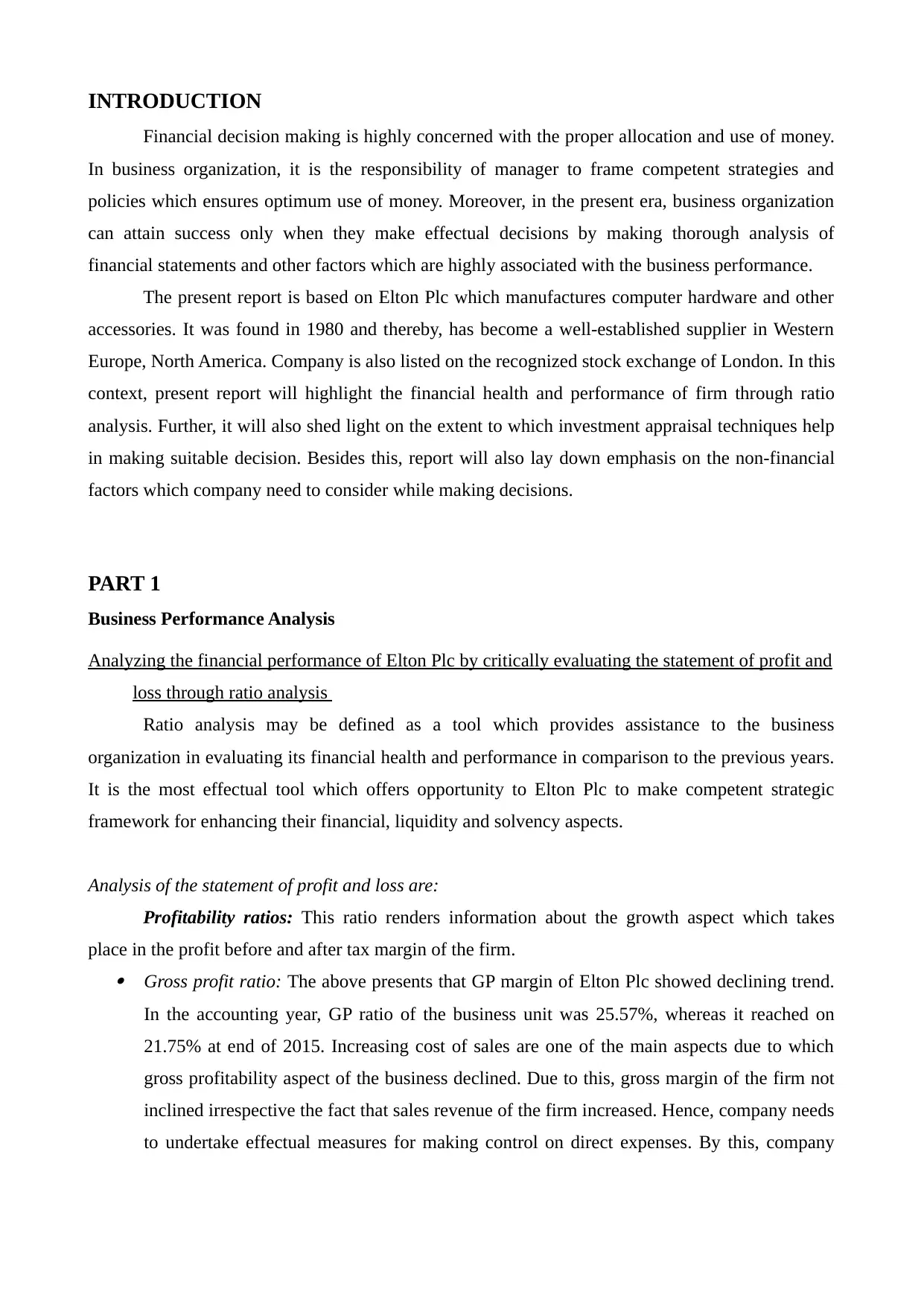
INTRODUCTION
Financial decision making is highly concerned with the proper allocation and use of money.
In business organization, it is the responsibility of manager to frame competent strategies and
policies which ensures optimum use of money. Moreover, in the present era, business organization
can attain success only when they make effectual decisions by making thorough analysis of
financial statements and other factors which are highly associated with the business performance.
The present report is based on Elton Plc which manufactures computer hardware and other
accessories. It was found in 1980 and thereby, has become a well-established supplier in Western
Europe, North America. Company is also listed on the recognized stock exchange of London. In this
context, present report will highlight the financial health and performance of firm through ratio
analysis. Further, it will also shed light on the extent to which investment appraisal techniques help
in making suitable decision. Besides this, report will also lay down emphasis on the non-financial
factors which company need to consider while making decisions.
PART 1
Business Performance Analysis
Analyzing the financial performance of Elton Plc by critically evaluating the statement of profit and
loss through ratio analysis
Ratio analysis may be defined as a tool which provides assistance to the business
organization in evaluating its financial health and performance in comparison to the previous years.
It is the most effectual tool which offers opportunity to Elton Plc to make competent strategic
framework for enhancing their financial, liquidity and solvency aspects.
Analysis of the statement of profit and loss are:
Profitability ratios: This ratio renders information about the growth aspect which takes
place in the profit before and after tax margin of the firm. Gross profit ratio: The above presents that GP margin of Elton Plc showed declining trend.
In the accounting year, GP ratio of the business unit was 25.57%, whereas it reached on
21.75% at end of 2015. Increasing cost of sales are one of the main aspects due to which
gross profitability aspect of the business declined. Due to this, gross margin of the firm not
inclined irrespective the fact that sales revenue of the firm increased. Hence, company needs
to undertake effectual measures for making control on direct expenses. By this, company
Financial decision making is highly concerned with the proper allocation and use of money.
In business organization, it is the responsibility of manager to frame competent strategies and
policies which ensures optimum use of money. Moreover, in the present era, business organization
can attain success only when they make effectual decisions by making thorough analysis of
financial statements and other factors which are highly associated with the business performance.
The present report is based on Elton Plc which manufactures computer hardware and other
accessories. It was found in 1980 and thereby, has become a well-established supplier in Western
Europe, North America. Company is also listed on the recognized stock exchange of London. In this
context, present report will highlight the financial health and performance of firm through ratio
analysis. Further, it will also shed light on the extent to which investment appraisal techniques help
in making suitable decision. Besides this, report will also lay down emphasis on the non-financial
factors which company need to consider while making decisions.
PART 1
Business Performance Analysis
Analyzing the financial performance of Elton Plc by critically evaluating the statement of profit and
loss through ratio analysis
Ratio analysis may be defined as a tool which provides assistance to the business
organization in evaluating its financial health and performance in comparison to the previous years.
It is the most effectual tool which offers opportunity to Elton Plc to make competent strategic
framework for enhancing their financial, liquidity and solvency aspects.
Analysis of the statement of profit and loss are:
Profitability ratios: This ratio renders information about the growth aspect which takes
place in the profit before and after tax margin of the firm. Gross profit ratio: The above presents that GP margin of Elton Plc showed declining trend.
In the accounting year, GP ratio of the business unit was 25.57%, whereas it reached on
21.75% at end of 2015. Increasing cost of sales are one of the main aspects due to which
gross profitability aspect of the business declined. Due to this, gross margin of the firm not
inclined irrespective the fact that sales revenue of the firm increased. Hence, company needs
to undertake effectual measures for making control on direct expenses. By this, company
Secure Best Marks with AI Grader
Need help grading? Try our AI Grader for instant feedback on your assignments.
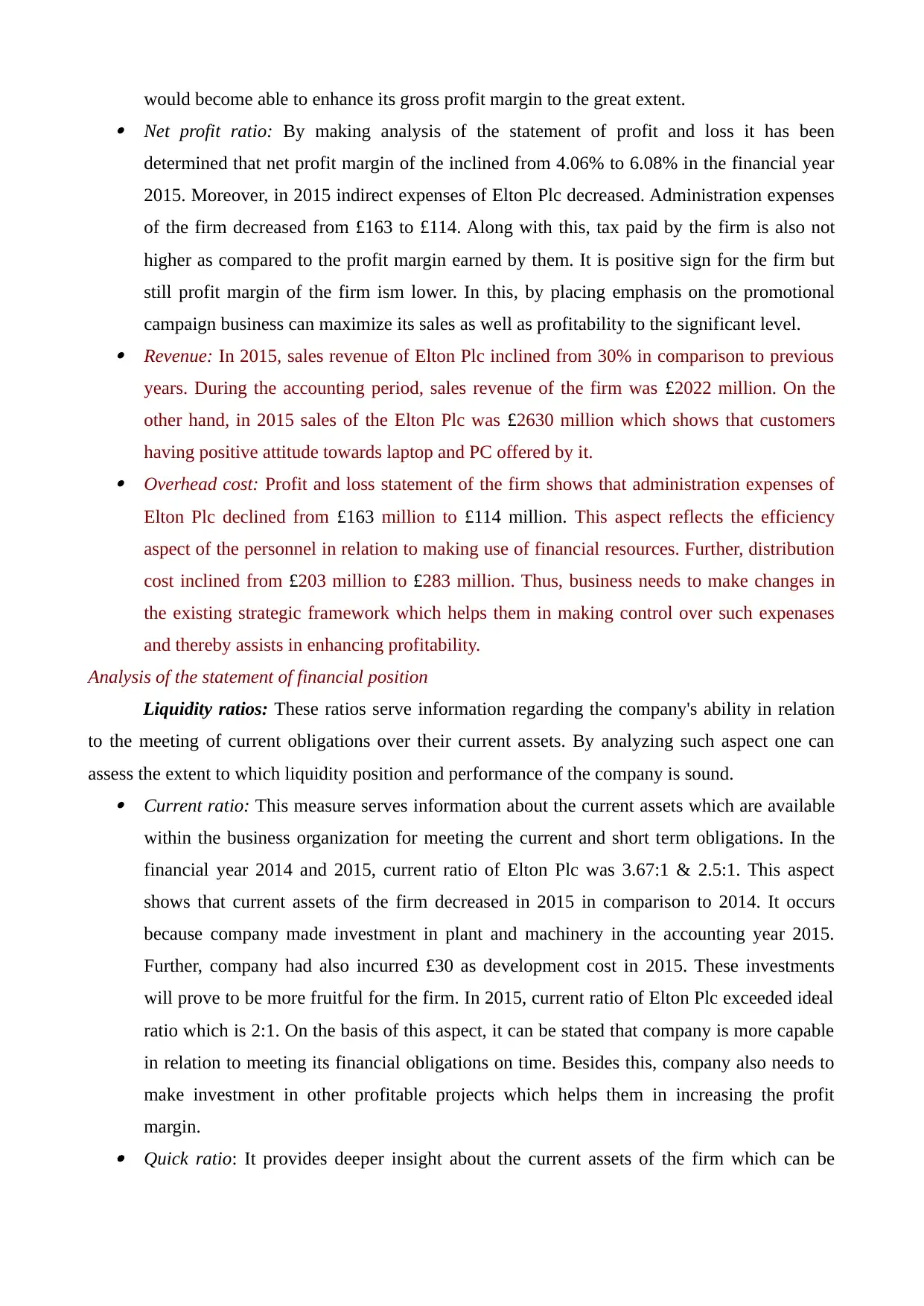
would become able to enhance its gross profit margin to the great extent. Net profit ratio: By making analysis of the statement of profit and loss it has been
determined that net profit margin of the inclined from 4.06% to 6.08% in the financial year
2015. Moreover, in 2015 indirect expenses of Elton Plc decreased. Administration expenses
of the firm decreased from £163 to £114. Along with this, tax paid by the firm is also not
higher as compared to the profit margin earned by them. It is positive sign for the firm but
still profit margin of the firm ism lower. In this, by placing emphasis on the promotional
campaign business can maximize its sales as well as profitability to the significant level. Revenue: In 2015, sales revenue of Elton Plc inclined from 30% in comparison to previous
years. During the accounting period, sales revenue of the firm was £2022 million. On the
other hand, in 2015 sales of the Elton Plc was £2630 million which shows that customers
having positive attitude towards laptop and PC offered by it. Overhead cost: Profit and loss statement of the firm shows that administration expenses of
Elton Plc declined from £163 million to £114 million. This aspect reflects the efficiency
aspect of the personnel in relation to making use of financial resources. Further, distribution
cost inclined from £203 million to £283 million. Thus, business needs to make changes in
the existing strategic framework which helps them in making control over such expenases
and thereby assists in enhancing profitability.
Analysis of the statement of financial position
Liquidity ratios: These ratios serve information regarding the company's ability in relation
to the meeting of current obligations over their current assets. By analyzing such aspect one can
assess the extent to which liquidity position and performance of the company is sound. Current ratio: This measure serves information about the current assets which are available
within the business organization for meeting the current and short term obligations. In the
financial year 2014 and 2015, current ratio of Elton Plc was 3.67:1 & 2.5:1. This aspect
shows that current assets of the firm decreased in 2015 in comparison to 2014. It occurs
because company made investment in plant and machinery in the accounting year 2015.
Further, company had also incurred £30 as development cost in 2015. These investments
will prove to be more fruitful for the firm. In 2015, current ratio of Elton Plc exceeded ideal
ratio which is 2:1. On the basis of this aspect, it can be stated that company is more capable
in relation to meeting its financial obligations on time. Besides this, company also needs to
make investment in other profitable projects which helps them in increasing the profit
margin. Quick ratio: It provides deeper insight about the current assets of the firm which can be
determined that net profit margin of the inclined from 4.06% to 6.08% in the financial year
2015. Moreover, in 2015 indirect expenses of Elton Plc decreased. Administration expenses
of the firm decreased from £163 to £114. Along with this, tax paid by the firm is also not
higher as compared to the profit margin earned by them. It is positive sign for the firm but
still profit margin of the firm ism lower. In this, by placing emphasis on the promotional
campaign business can maximize its sales as well as profitability to the significant level. Revenue: In 2015, sales revenue of Elton Plc inclined from 30% in comparison to previous
years. During the accounting period, sales revenue of the firm was £2022 million. On the
other hand, in 2015 sales of the Elton Plc was £2630 million which shows that customers
having positive attitude towards laptop and PC offered by it. Overhead cost: Profit and loss statement of the firm shows that administration expenses of
Elton Plc declined from £163 million to £114 million. This aspect reflects the efficiency
aspect of the personnel in relation to making use of financial resources. Further, distribution
cost inclined from £203 million to £283 million. Thus, business needs to make changes in
the existing strategic framework which helps them in making control over such expenases
and thereby assists in enhancing profitability.
Analysis of the statement of financial position
Liquidity ratios: These ratios serve information regarding the company's ability in relation
to the meeting of current obligations over their current assets. By analyzing such aspect one can
assess the extent to which liquidity position and performance of the company is sound. Current ratio: This measure serves information about the current assets which are available
within the business organization for meeting the current and short term obligations. In the
financial year 2014 and 2015, current ratio of Elton Plc was 3.67:1 & 2.5:1. This aspect
shows that current assets of the firm decreased in 2015 in comparison to 2014. It occurs
because company made investment in plant and machinery in the accounting year 2015.
Further, company had also incurred £30 as development cost in 2015. These investments
will prove to be more fruitful for the firm. In 2015, current ratio of Elton Plc exceeded ideal
ratio which is 2:1. On the basis of this aspect, it can be stated that company is more capable
in relation to meeting its financial obligations on time. Besides this, company also needs to
make investment in other profitable projects which helps them in increasing the profit
margin. Quick ratio: It provides deeper insight about the current assets of the firm which can be
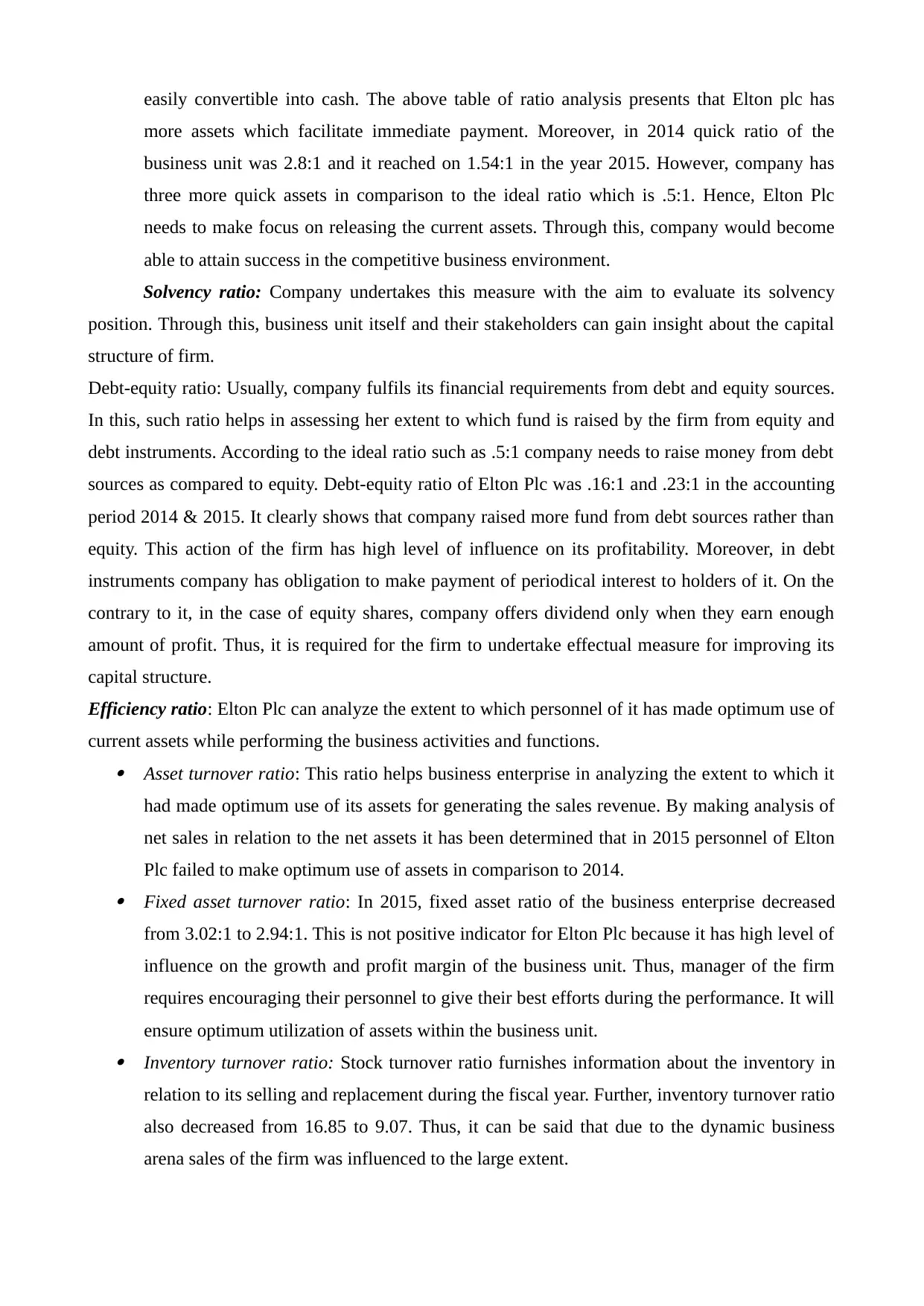
easily convertible into cash. The above table of ratio analysis presents that Elton plc has
more assets which facilitate immediate payment. Moreover, in 2014 quick ratio of the
business unit was 2.8:1 and it reached on 1.54:1 in the year 2015. However, company has
three more quick assets in comparison to the ideal ratio which is .5:1. Hence, Elton Plc
needs to make focus on releasing the current assets. Through this, company would become
able to attain success in the competitive business environment.
Solvency ratio: Company undertakes this measure with the aim to evaluate its solvency
position. Through this, business unit itself and their stakeholders can gain insight about the capital
structure of firm.
Debt-equity ratio: Usually, company fulfils its financial requirements from debt and equity sources.
In this, such ratio helps in assessing her extent to which fund is raised by the firm from equity and
debt instruments. According to the ideal ratio such as .5:1 company needs to raise money from debt
sources as compared to equity. Debt-equity ratio of Elton Plc was .16:1 and .23:1 in the accounting
period 2014 & 2015. It clearly shows that company raised more fund from debt sources rather than
equity. This action of the firm has high level of influence on its profitability. Moreover, in debt
instruments company has obligation to make payment of periodical interest to holders of it. On the
contrary to it, in the case of equity shares, company offers dividend only when they earn enough
amount of profit. Thus, it is required for the firm to undertake effectual measure for improving its
capital structure.
Efficiency ratio: Elton Plc can analyze the extent to which personnel of it has made optimum use of
current assets while performing the business activities and functions. Asset turnover ratio: This ratio helps business enterprise in analyzing the extent to which it
had made optimum use of its assets for generating the sales revenue. By making analysis of
net sales in relation to the net assets it has been determined that in 2015 personnel of Elton
Plc failed to make optimum use of assets in comparison to 2014. Fixed asset turnover ratio: In 2015, fixed asset ratio of the business enterprise decreased
from 3.02:1 to 2.94:1. This is not positive indicator for Elton Plc because it has high level of
influence on the growth and profit margin of the business unit. Thus, manager of the firm
requires encouraging their personnel to give their best efforts during the performance. It will
ensure optimum utilization of assets within the business unit. Inventory turnover ratio: Stock turnover ratio furnishes information about the inventory in
relation to its selling and replacement during the fiscal year. Further, inventory turnover ratio
also decreased from 16.85 to 9.07. Thus, it can be said that due to the dynamic business
arena sales of the firm was influenced to the large extent.
more assets which facilitate immediate payment. Moreover, in 2014 quick ratio of the
business unit was 2.8:1 and it reached on 1.54:1 in the year 2015. However, company has
three more quick assets in comparison to the ideal ratio which is .5:1. Hence, Elton Plc
needs to make focus on releasing the current assets. Through this, company would become
able to attain success in the competitive business environment.
Solvency ratio: Company undertakes this measure with the aim to evaluate its solvency
position. Through this, business unit itself and their stakeholders can gain insight about the capital
structure of firm.
Debt-equity ratio: Usually, company fulfils its financial requirements from debt and equity sources.
In this, such ratio helps in assessing her extent to which fund is raised by the firm from equity and
debt instruments. According to the ideal ratio such as .5:1 company needs to raise money from debt
sources as compared to equity. Debt-equity ratio of Elton Plc was .16:1 and .23:1 in the accounting
period 2014 & 2015. It clearly shows that company raised more fund from debt sources rather than
equity. This action of the firm has high level of influence on its profitability. Moreover, in debt
instruments company has obligation to make payment of periodical interest to holders of it. On the
contrary to it, in the case of equity shares, company offers dividend only when they earn enough
amount of profit. Thus, it is required for the firm to undertake effectual measure for improving its
capital structure.
Efficiency ratio: Elton Plc can analyze the extent to which personnel of it has made optimum use of
current assets while performing the business activities and functions. Asset turnover ratio: This ratio helps business enterprise in analyzing the extent to which it
had made optimum use of its assets for generating the sales revenue. By making analysis of
net sales in relation to the net assets it has been determined that in 2015 personnel of Elton
Plc failed to make optimum use of assets in comparison to 2014. Fixed asset turnover ratio: In 2015, fixed asset ratio of the business enterprise decreased
from 3.02:1 to 2.94:1. This is not positive indicator for Elton Plc because it has high level of
influence on the growth and profit margin of the business unit. Thus, manager of the firm
requires encouraging their personnel to give their best efforts during the performance. It will
ensure optimum utilization of assets within the business unit. Inventory turnover ratio: Stock turnover ratio furnishes information about the inventory in
relation to its selling and replacement during the fiscal year. Further, inventory turnover ratio
also decreased from 16.85 to 9.07. Thus, it can be said that due to the dynamic business
arena sales of the firm was influenced to the large extent.
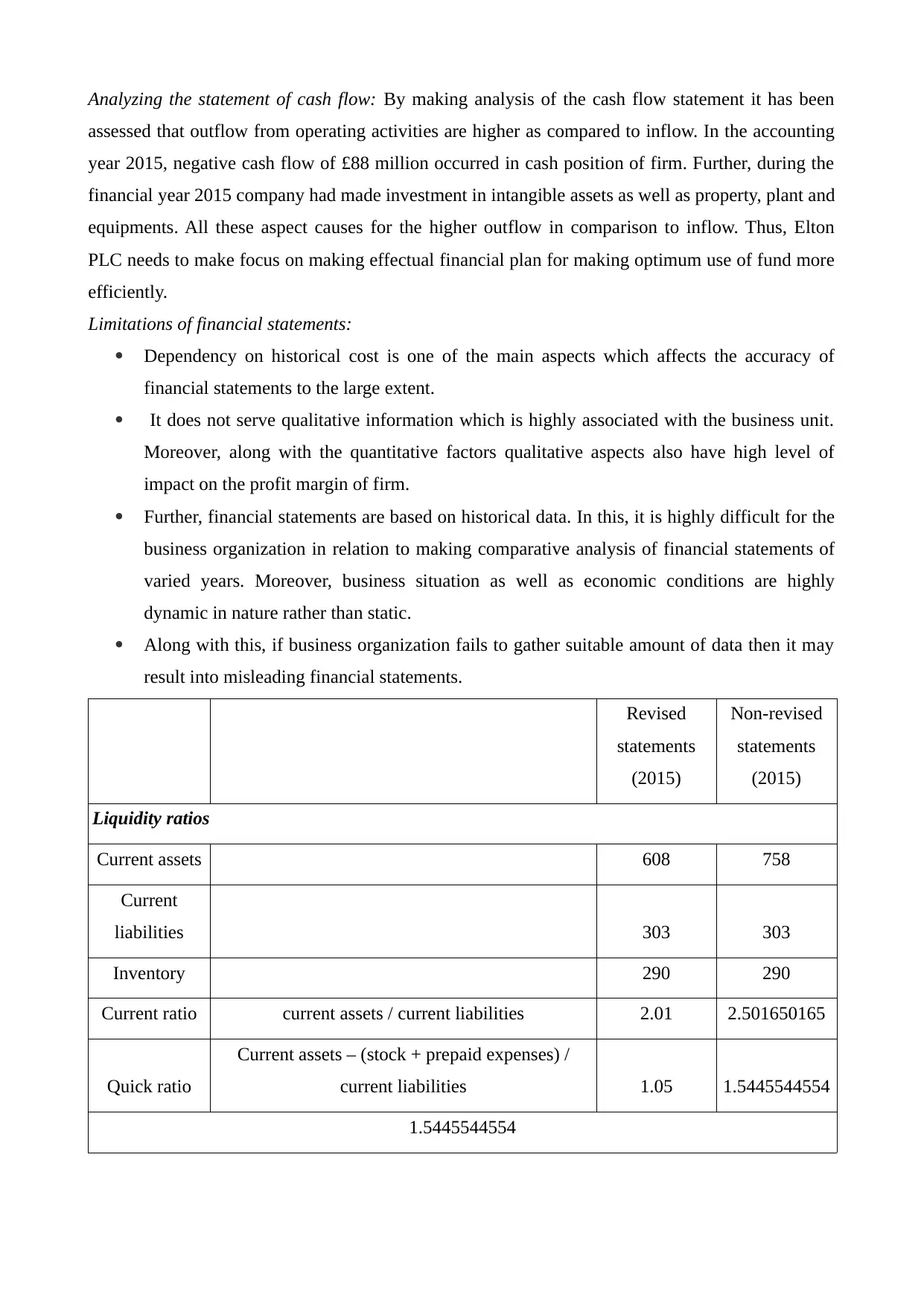
Analyzing the statement of cash flow: By making analysis of the cash flow statement it has been
assessed that outflow from operating activities are higher as compared to inflow. In the accounting
year 2015, negative cash flow of £88 million occurred in cash position of firm. Further, during the
financial year 2015 company had made investment in intangible assets as well as property, plant and
equipments. All these aspect causes for the higher outflow in comparison to inflow. Thus, Elton
PLC needs to make focus on making effectual financial plan for making optimum use of fund more
efficiently.
Limitations of financial statements:
Dependency on historical cost is one of the main aspects which affects the accuracy of
financial statements to the large extent.
It does not serve qualitative information which is highly associated with the business unit.
Moreover, along with the quantitative factors qualitative aspects also have high level of
impact on the profit margin of firm.
Further, financial statements are based on historical data. In this, it is highly difficult for the
business organization in relation to making comparative analysis of financial statements of
varied years. Moreover, business situation as well as economic conditions are highly
dynamic in nature rather than static.
Along with this, if business organization fails to gather suitable amount of data then it may
result into misleading financial statements.
Revised
statements
(2015)
Non-revised
statements
(2015)
Liquidity ratios
Current assets 608 758
Current
liabilities 303 303
Inventory 290 290
Current ratio current assets / current liabilities 2.01 2.501650165
Quick ratio
Current assets – (stock + prepaid expenses) /
current liabilities 1.05 1.5445544554
1.5445544554
assessed that outflow from operating activities are higher as compared to inflow. In the accounting
year 2015, negative cash flow of £88 million occurred in cash position of firm. Further, during the
financial year 2015 company had made investment in intangible assets as well as property, plant and
equipments. All these aspect causes for the higher outflow in comparison to inflow. Thus, Elton
PLC needs to make focus on making effectual financial plan for making optimum use of fund more
efficiently.
Limitations of financial statements:
Dependency on historical cost is one of the main aspects which affects the accuracy of
financial statements to the large extent.
It does not serve qualitative information which is highly associated with the business unit.
Moreover, along with the quantitative factors qualitative aspects also have high level of
impact on the profit margin of firm.
Further, financial statements are based on historical data. In this, it is highly difficult for the
business organization in relation to making comparative analysis of financial statements of
varied years. Moreover, business situation as well as economic conditions are highly
dynamic in nature rather than static.
Along with this, if business organization fails to gather suitable amount of data then it may
result into misleading financial statements.
Revised
statements
(2015)
Non-revised
statements
(2015)
Liquidity ratios
Current assets 608 758
Current
liabilities 303 303
Inventory 290 290
Current ratio current assets / current liabilities 2.01 2.501650165
Quick ratio
Current assets – (stock + prepaid expenses) /
current liabilities 1.05 1.5445544554
1.5445544554
Paraphrase This Document
Need a fresh take? Get an instant paraphrase of this document with our AI Paraphraser
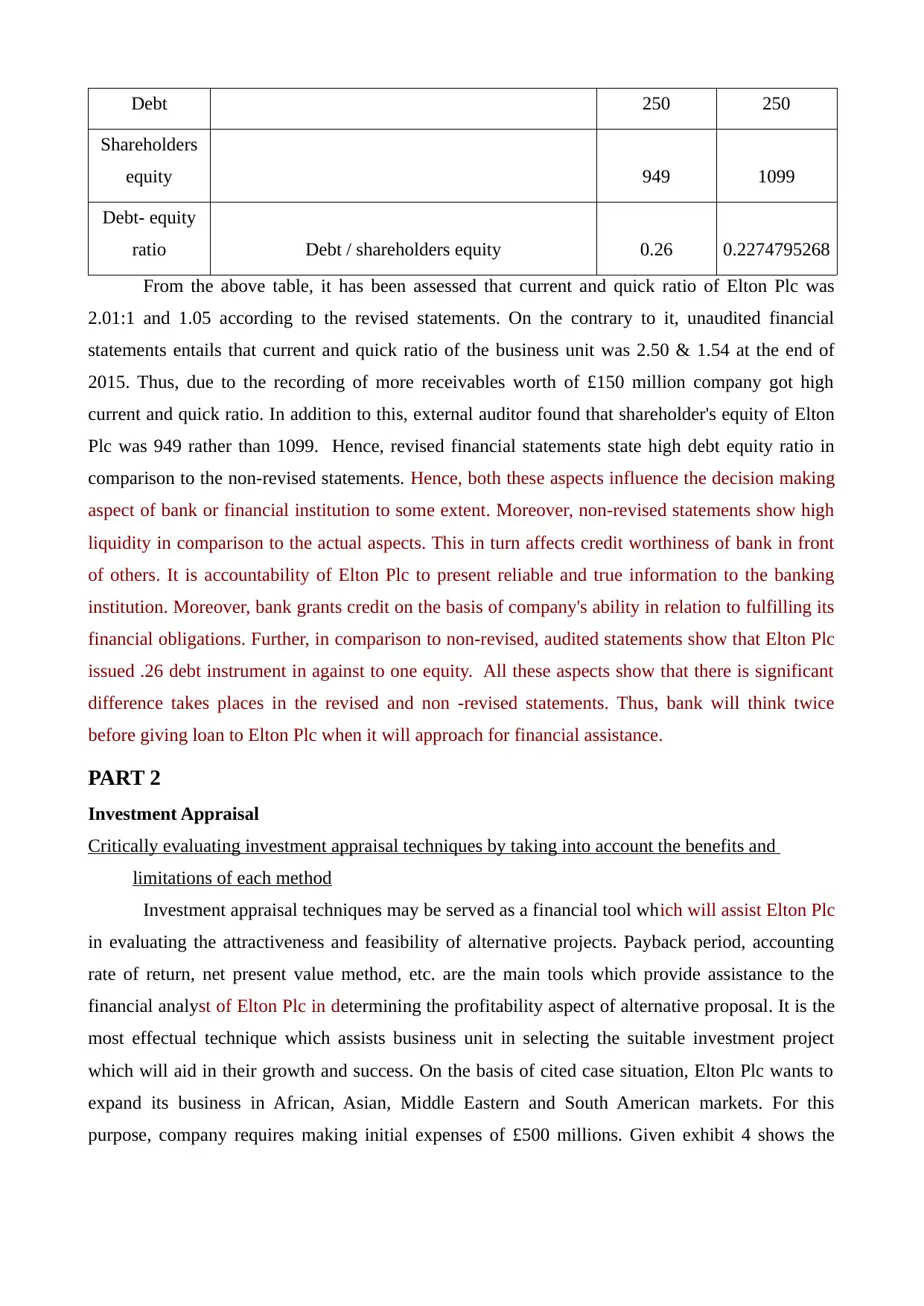
Debt 250 250
Shareholders
equity 949 1099
Debt- equity
ratio Debt / shareholders equity 0.26 0.2274795268
From the above table, it has been assessed that current and quick ratio of Elton Plc was
2.01:1 and 1.05 according to the revised statements. On the contrary to it, unaudited financial
statements entails that current and quick ratio of the business unit was 2.50 & 1.54 at the end of
2015. Thus, due to the recording of more receivables worth of £150 million company got high
current and quick ratio. In addition to this, external auditor found that shareholder's equity of Elton
Plc was 949 rather than 1099. Hence, revised financial statements state high debt equity ratio in
comparison to the non-revised statements. Hence, both these aspects influence the decision making
aspect of bank or financial institution to some extent. Moreover, non-revised statements show high
liquidity in comparison to the actual aspects. This in turn affects credit worthiness of bank in front
of others. It is accountability of Elton Plc to present reliable and true information to the banking
institution. Moreover, bank grants credit on the basis of company's ability in relation to fulfilling its
financial obligations. Further, in comparison to non-revised, audited statements show that Elton Plc
issued .26 debt instrument in against to one equity. All these aspects show that there is significant
difference takes places in the revised and non -revised statements. Thus, bank will think twice
before giving loan to Elton Plc when it will approach for financial assistance.
PART 2
Investment Appraisal
Critically evaluating investment appraisal techniques by taking into account the benefits and
limitations of each method
Investment appraisal techniques may be served as a financial tool which will assist Elton Plc
in evaluating the attractiveness and feasibility of alternative projects. Payback period, accounting
rate of return, net present value method, etc. are the main tools which provide assistance to the
financial analyst of Elton Plc in determining the profitability aspect of alternative proposal. It is the
most effectual technique which assists business unit in selecting the suitable investment project
which will aid in their growth and success. On the basis of cited case situation, Elton Plc wants to
expand its business in African, Asian, Middle Eastern and South American markets. For this
purpose, company requires making initial expenses of £500 millions. Given exhibit 4 shows the
Shareholders
equity 949 1099
Debt- equity
ratio Debt / shareholders equity 0.26 0.2274795268
From the above table, it has been assessed that current and quick ratio of Elton Plc was
2.01:1 and 1.05 according to the revised statements. On the contrary to it, unaudited financial
statements entails that current and quick ratio of the business unit was 2.50 & 1.54 at the end of
2015. Thus, due to the recording of more receivables worth of £150 million company got high
current and quick ratio. In addition to this, external auditor found that shareholder's equity of Elton
Plc was 949 rather than 1099. Hence, revised financial statements state high debt equity ratio in
comparison to the non-revised statements. Hence, both these aspects influence the decision making
aspect of bank or financial institution to some extent. Moreover, non-revised statements show high
liquidity in comparison to the actual aspects. This in turn affects credit worthiness of bank in front
of others. It is accountability of Elton Plc to present reliable and true information to the banking
institution. Moreover, bank grants credit on the basis of company's ability in relation to fulfilling its
financial obligations. Further, in comparison to non-revised, audited statements show that Elton Plc
issued .26 debt instrument in against to one equity. All these aspects show that there is significant
difference takes places in the revised and non -revised statements. Thus, bank will think twice
before giving loan to Elton Plc when it will approach for financial assistance.
PART 2
Investment Appraisal
Critically evaluating investment appraisal techniques by taking into account the benefits and
limitations of each method
Investment appraisal techniques may be served as a financial tool which will assist Elton Plc
in evaluating the attractiveness and feasibility of alternative projects. Payback period, accounting
rate of return, net present value method, etc. are the main tools which provide assistance to the
financial analyst of Elton Plc in determining the profitability aspect of alternative proposal. It is the
most effectual technique which assists business unit in selecting the suitable investment project
which will aid in their growth and success. On the basis of cited case situation, Elton Plc wants to
expand its business in African, Asian, Middle Eastern and South American markets. For this
purpose, company requires making initial expenses of £500 millions. Given exhibit 4 shows the
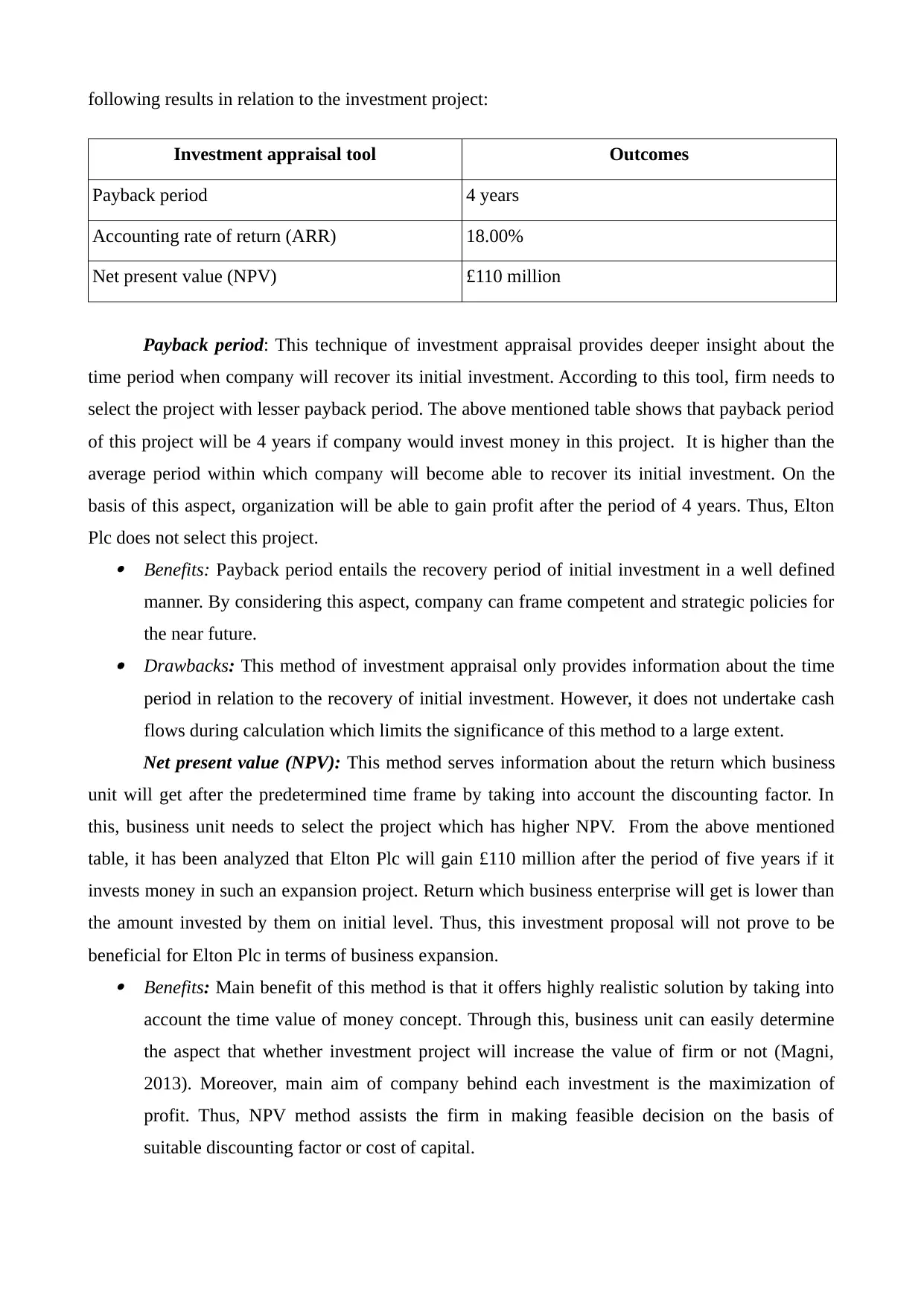
following results in relation to the investment project:
Investment appraisal tool Outcomes
Payback period 4 years
Accounting rate of return (ARR) 18.00%
Net present value (NPV) £110 million
Payback period: This technique of investment appraisal provides deeper insight about the
time period when company will recover its initial investment. According to this tool, firm needs to
select the project with lesser payback period. The above mentioned table shows that payback period
of this project will be 4 years if company would invest money in this project. It is higher than the
average period within which company will become able to recover its initial investment. On the
basis of this aspect, organization will be able to gain profit after the period of 4 years. Thus, Elton
Plc does not select this project. Benefits: Payback period entails the recovery period of initial investment in a well defined
manner. By considering this aspect, company can frame competent and strategic policies for
the near future. Drawbacks: This method of investment appraisal only provides information about the time
period in relation to the recovery of initial investment. However, it does not undertake cash
flows during calculation which limits the significance of this method to a large extent.
Net present value (NPV): This method serves information about the return which business
unit will get after the predetermined time frame by taking into account the discounting factor. In
this, business unit needs to select the project which has higher NPV. From the above mentioned
table, it has been analyzed that Elton Plc will gain £110 million after the period of five years if it
invests money in such an expansion project. Return which business enterprise will get is lower than
the amount invested by them on initial level. Thus, this investment proposal will not prove to be
beneficial for Elton Plc in terms of business expansion. Benefits: Main benefit of this method is that it offers highly realistic solution by taking into
account the time value of money concept. Through this, business unit can easily determine
the aspect that whether investment project will increase the value of firm or not (Magni,
2013). Moreover, main aim of company behind each investment is the maximization of
profit. Thus, NPV method assists the firm in making feasible decision on the basis of
suitable discounting factor or cost of capital.
Investment appraisal tool Outcomes
Payback period 4 years
Accounting rate of return (ARR) 18.00%
Net present value (NPV) £110 million
Payback period: This technique of investment appraisal provides deeper insight about the
time period when company will recover its initial investment. According to this tool, firm needs to
select the project with lesser payback period. The above mentioned table shows that payback period
of this project will be 4 years if company would invest money in this project. It is higher than the
average period within which company will become able to recover its initial investment. On the
basis of this aspect, organization will be able to gain profit after the period of 4 years. Thus, Elton
Plc does not select this project. Benefits: Payback period entails the recovery period of initial investment in a well defined
manner. By considering this aspect, company can frame competent and strategic policies for
the near future. Drawbacks: This method of investment appraisal only provides information about the time
period in relation to the recovery of initial investment. However, it does not undertake cash
flows during calculation which limits the significance of this method to a large extent.
Net present value (NPV): This method serves information about the return which business
unit will get after the predetermined time frame by taking into account the discounting factor. In
this, business unit needs to select the project which has higher NPV. From the above mentioned
table, it has been analyzed that Elton Plc will gain £110 million after the period of five years if it
invests money in such an expansion project. Return which business enterprise will get is lower than
the amount invested by them on initial level. Thus, this investment proposal will not prove to be
beneficial for Elton Plc in terms of business expansion. Benefits: Main benefit of this method is that it offers highly realistic solution by taking into
account the time value of money concept. Through this, business unit can easily determine
the aspect that whether investment project will increase the value of firm or not (Magni,
2013). Moreover, main aim of company behind each investment is the maximization of
profit. Thus, NPV method assists the firm in making feasible decision on the basis of
suitable discounting factor or cost of capital.
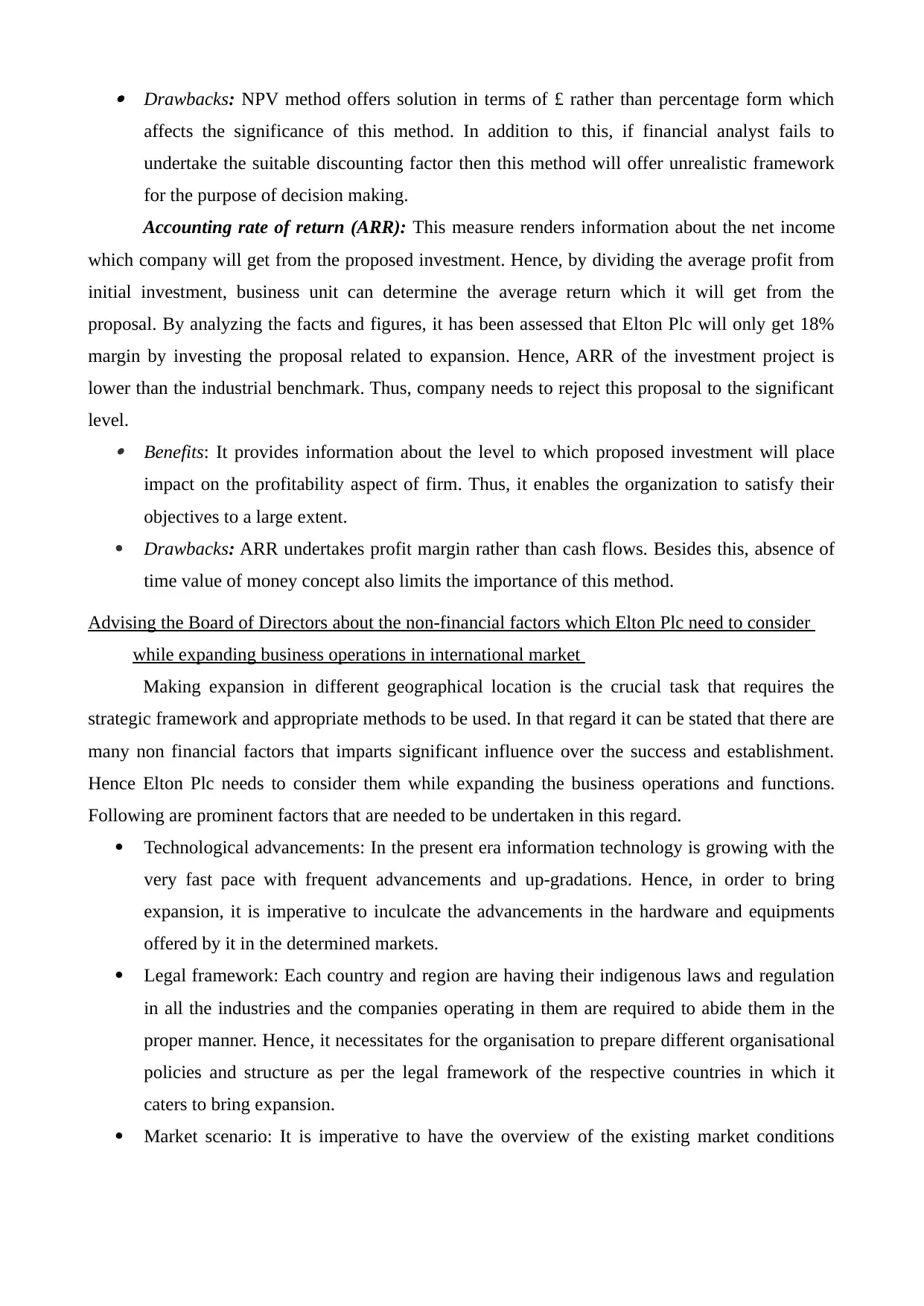
Drawbacks: NPV method offers solution in terms of £ rather than percentage form which
affects the significance of this method. In addition to this, if financial analyst fails to
undertake the suitable discounting factor then this method will offer unrealistic framework
for the purpose of decision making.
Accounting rate of return (ARR): This measure renders information about the net income
which company will get from the proposed investment. Hence, by dividing the average profit from
initial investment, business unit can determine the average return which it will get from the
proposal. By analyzing the facts and figures, it has been assessed that Elton Plc will only get 18%
margin by investing the proposal related to expansion. Hence, ARR of the investment project is
lower than the industrial benchmark. Thus, company needs to reject this proposal to the significant
level. Benefits: It provides information about the level to which proposed investment will place
impact on the profitability aspect of firm. Thus, it enables the organization to satisfy their
objectives to a large extent.
Drawbacks: ARR undertakes profit margin rather than cash flows. Besides this, absence of
time value of money concept also limits the importance of this method.
Advising the Board of Directors about the non-financial factors which Elton Plc need to consider
while expanding business operations in international market
Making expansion in different geographical location is the crucial task that requires the
strategic framework and appropriate methods to be used. In that regard it can be stated that there are
many non financial factors that imparts significant influence over the success and establishment.
Hence Elton Plc needs to consider them while expanding the business operations and functions.
Following are prominent factors that are needed to be undertaken in this regard.
Technological advancements: In the present era information technology is growing with the
very fast pace with frequent advancements and up-gradations. Hence, in order to bring
expansion, it is imperative to inculcate the advancements in the hardware and equipments
offered by it in the determined markets.
Legal framework: Each country and region are having their indigenous laws and regulation
in all the industries and the companies operating in them are required to abide them in the
proper manner. Hence, it necessitates for the organisation to prepare different organisational
policies and structure as per the legal framework of the respective countries in which it
caters to bring expansion.
Market scenario: It is imperative to have the overview of the existing market conditions
affects the significance of this method. In addition to this, if financial analyst fails to
undertake the suitable discounting factor then this method will offer unrealistic framework
for the purpose of decision making.
Accounting rate of return (ARR): This measure renders information about the net income
which company will get from the proposed investment. Hence, by dividing the average profit from
initial investment, business unit can determine the average return which it will get from the
proposal. By analyzing the facts and figures, it has been assessed that Elton Plc will only get 18%
margin by investing the proposal related to expansion. Hence, ARR of the investment project is
lower than the industrial benchmark. Thus, company needs to reject this proposal to the significant
level. Benefits: It provides information about the level to which proposed investment will place
impact on the profitability aspect of firm. Thus, it enables the organization to satisfy their
objectives to a large extent.
Drawbacks: ARR undertakes profit margin rather than cash flows. Besides this, absence of
time value of money concept also limits the importance of this method.
Advising the Board of Directors about the non-financial factors which Elton Plc need to consider
while expanding business operations in international market
Making expansion in different geographical location is the crucial task that requires the
strategic framework and appropriate methods to be used. In that regard it can be stated that there are
many non financial factors that imparts significant influence over the success and establishment.
Hence Elton Plc needs to consider them while expanding the business operations and functions.
Following are prominent factors that are needed to be undertaken in this regard.
Technological advancements: In the present era information technology is growing with the
very fast pace with frequent advancements and up-gradations. Hence, in order to bring
expansion, it is imperative to inculcate the advancements in the hardware and equipments
offered by it in the determined markets.
Legal framework: Each country and region are having their indigenous laws and regulation
in all the industries and the companies operating in them are required to abide them in the
proper manner. Hence, it necessitates for the organisation to prepare different organisational
policies and structure as per the legal framework of the respective countries in which it
caters to bring expansion.
Market scenario: It is imperative to have the overview of the existing market conditions
Secure Best Marks with AI Grader
Need help grading? Try our AI Grader for instant feedback on your assignments.
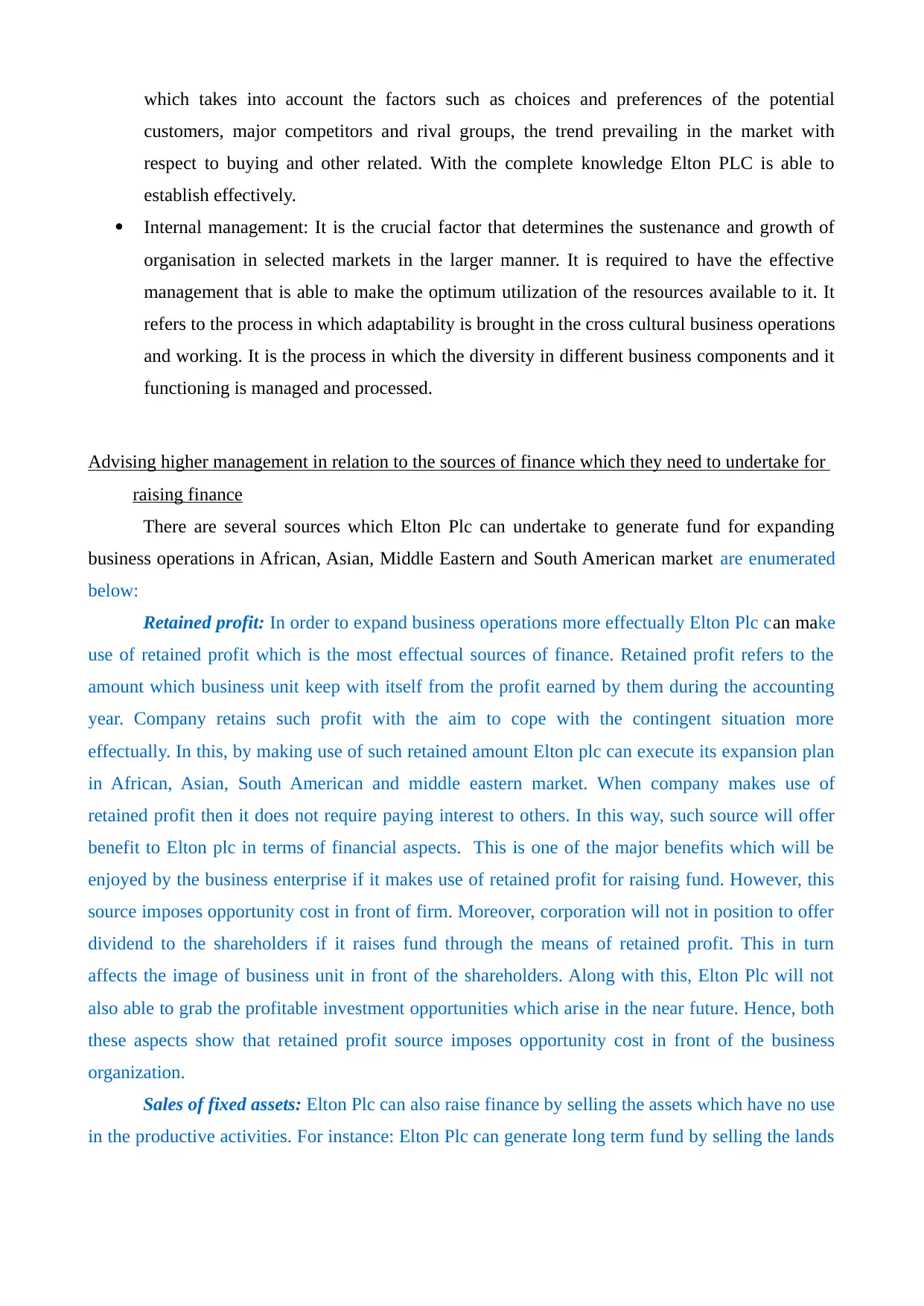
which takes into account the factors such as choices and preferences of the potential
customers, major competitors and rival groups, the trend prevailing in the market with
respect to buying and other related. With the complete knowledge Elton PLC is able to
establish effectively.
Internal management: It is the crucial factor that determines the sustenance and growth of
organisation in selected markets in the larger manner. It is required to have the effective
management that is able to make the optimum utilization of the resources available to it. It
refers to the process in which adaptability is brought in the cross cultural business operations
and working. It is the process in which the diversity in different business components and it
functioning is managed and processed.
Advising higher management in relation to the sources of finance which they need to undertake for
raising finance
There are several sources which Elton Plc can undertake to generate fund for expanding
business operations in African, Asian, Middle Eastern and South American market are enumerated
below:
Retained profit: In order to expand business operations more effectually Elton Plc can make
use of retained profit which is the most effectual sources of finance. Retained profit refers to the
amount which business unit keep with itself from the profit earned by them during the accounting
year. Company retains such profit with the aim to cope with the contingent situation more
effectually. In this, by making use of such retained amount Elton plc can execute its expansion plan
in African, Asian, South American and middle eastern market. When company makes use of
retained profit then it does not require paying interest to others. In this way, such source will offer
benefit to Elton plc in terms of financial aspects. This is one of the major benefits which will be
enjoyed by the business enterprise if it makes use of retained profit for raising fund. However, this
source imposes opportunity cost in front of firm. Moreover, corporation will not in position to offer
dividend to the shareholders if it raises fund through the means of retained profit. This in turn
affects the image of business unit in front of the shareholders. Along with this, Elton Plc will not
also able to grab the profitable investment opportunities which arise in the near future. Hence, both
these aspects show that retained profit source imposes opportunity cost in front of the business
organization.
Sales of fixed assets: Elton Plc can also raise finance by selling the assets which have no use
in the productive activities. For instance: Elton Plc can generate long term fund by selling the lands
customers, major competitors and rival groups, the trend prevailing in the market with
respect to buying and other related. With the complete knowledge Elton PLC is able to
establish effectively.
Internal management: It is the crucial factor that determines the sustenance and growth of
organisation in selected markets in the larger manner. It is required to have the effective
management that is able to make the optimum utilization of the resources available to it. It
refers to the process in which adaptability is brought in the cross cultural business operations
and working. It is the process in which the diversity in different business components and it
functioning is managed and processed.
Advising higher management in relation to the sources of finance which they need to undertake for
raising finance
There are several sources which Elton Plc can undertake to generate fund for expanding
business operations in African, Asian, Middle Eastern and South American market are enumerated
below:
Retained profit: In order to expand business operations more effectually Elton Plc can make
use of retained profit which is the most effectual sources of finance. Retained profit refers to the
amount which business unit keep with itself from the profit earned by them during the accounting
year. Company retains such profit with the aim to cope with the contingent situation more
effectually. In this, by making use of such retained amount Elton plc can execute its expansion plan
in African, Asian, South American and middle eastern market. When company makes use of
retained profit then it does not require paying interest to others. In this way, such source will offer
benefit to Elton plc in terms of financial aspects. This is one of the major benefits which will be
enjoyed by the business enterprise if it makes use of retained profit for raising fund. However, this
source imposes opportunity cost in front of firm. Moreover, corporation will not in position to offer
dividend to the shareholders if it raises fund through the means of retained profit. This in turn
affects the image of business unit in front of the shareholders. Along with this, Elton Plc will not
also able to grab the profitable investment opportunities which arise in the near future. Hence, both
these aspects show that retained profit source imposes opportunity cost in front of the business
organization.
Sales of fixed assets: Elton Plc can also raise finance by selling the assets which have no use
in the productive activities. For instance: Elton Plc can generate long term fund by selling the lands
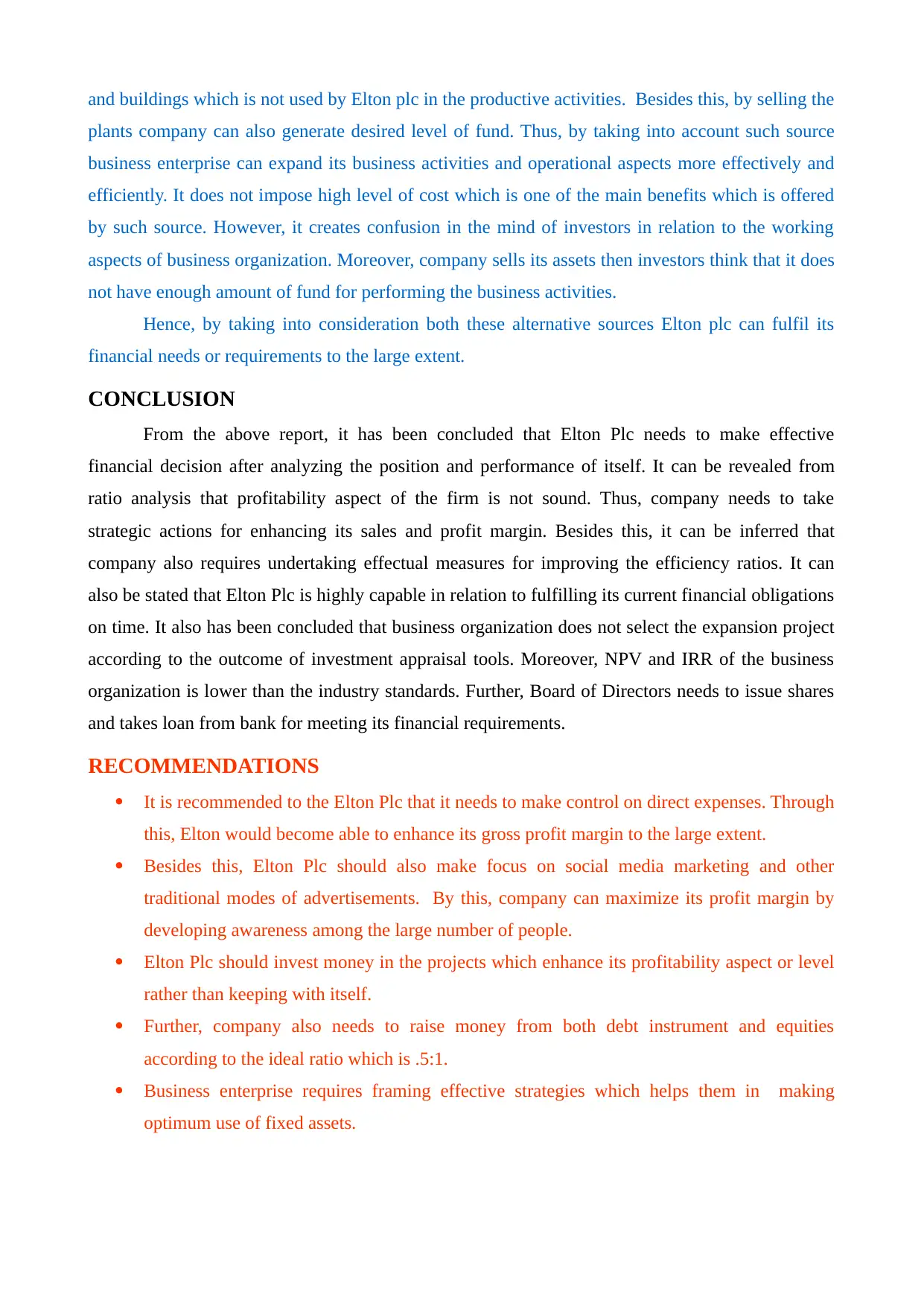
and buildings which is not used by Elton plc in the productive activities. Besides this, by selling the
plants company can also generate desired level of fund. Thus, by taking into account such source
business enterprise can expand its business activities and operational aspects more effectively and
efficiently. It does not impose high level of cost which is one of the main benefits which is offered
by such source. However, it creates confusion in the mind of investors in relation to the working
aspects of business organization. Moreover, company sells its assets then investors think that it does
not have enough amount of fund for performing the business activities.
Hence, by taking into consideration both these alternative sources Elton plc can fulfil its
financial needs or requirements to the large extent.
CONCLUSION
From the above report, it has been concluded that Elton Plc needs to make effective
financial decision after analyzing the position and performance of itself. It can be revealed from
ratio analysis that profitability aspect of the firm is not sound. Thus, company needs to take
strategic actions for enhancing its sales and profit margin. Besides this, it can be inferred that
company also requires undertaking effectual measures for improving the efficiency ratios. It can
also be stated that Elton Plc is highly capable in relation to fulfilling its current financial obligations
on time. It also has been concluded that business organization does not select the expansion project
according to the outcome of investment appraisal tools. Moreover, NPV and IRR of the business
organization is lower than the industry standards. Further, Board of Directors needs to issue shares
and takes loan from bank for meeting its financial requirements.
RECOMMENDATIONS
It is recommended to the Elton Plc that it needs to make control on direct expenses. Through
this, Elton would become able to enhance its gross profit margin to the large extent.
Besides this, Elton Plc should also make focus on social media marketing and other
traditional modes of advertisements. By this, company can maximize its profit margin by
developing awareness among the large number of people.
Elton Plc should invest money in the projects which enhance its profitability aspect or level
rather than keeping with itself.
Further, company also needs to raise money from both debt instrument and equities
according to the ideal ratio which is .5:1.
Business enterprise requires framing effective strategies which helps them in making
optimum use of fixed assets.
plants company can also generate desired level of fund. Thus, by taking into account such source
business enterprise can expand its business activities and operational aspects more effectively and
efficiently. It does not impose high level of cost which is one of the main benefits which is offered
by such source. However, it creates confusion in the mind of investors in relation to the working
aspects of business organization. Moreover, company sells its assets then investors think that it does
not have enough amount of fund for performing the business activities.
Hence, by taking into consideration both these alternative sources Elton plc can fulfil its
financial needs or requirements to the large extent.
CONCLUSION
From the above report, it has been concluded that Elton Plc needs to make effective
financial decision after analyzing the position and performance of itself. It can be revealed from
ratio analysis that profitability aspect of the firm is not sound. Thus, company needs to take
strategic actions for enhancing its sales and profit margin. Besides this, it can be inferred that
company also requires undertaking effectual measures for improving the efficiency ratios. It can
also be stated that Elton Plc is highly capable in relation to fulfilling its current financial obligations
on time. It also has been concluded that business organization does not select the expansion project
according to the outcome of investment appraisal tools. Moreover, NPV and IRR of the business
organization is lower than the industry standards. Further, Board of Directors needs to issue shares
and takes loan from bank for meeting its financial requirements.
RECOMMENDATIONS
It is recommended to the Elton Plc that it needs to make control on direct expenses. Through
this, Elton would become able to enhance its gross profit margin to the large extent.
Besides this, Elton Plc should also make focus on social media marketing and other
traditional modes of advertisements. By this, company can maximize its profit margin by
developing awareness among the large number of people.
Elton Plc should invest money in the projects which enhance its profitability aspect or level
rather than keeping with itself.
Further, company also needs to raise money from both debt instrument and equities
according to the ideal ratio which is .5:1.
Business enterprise requires framing effective strategies which helps them in making
optimum use of fixed assets.
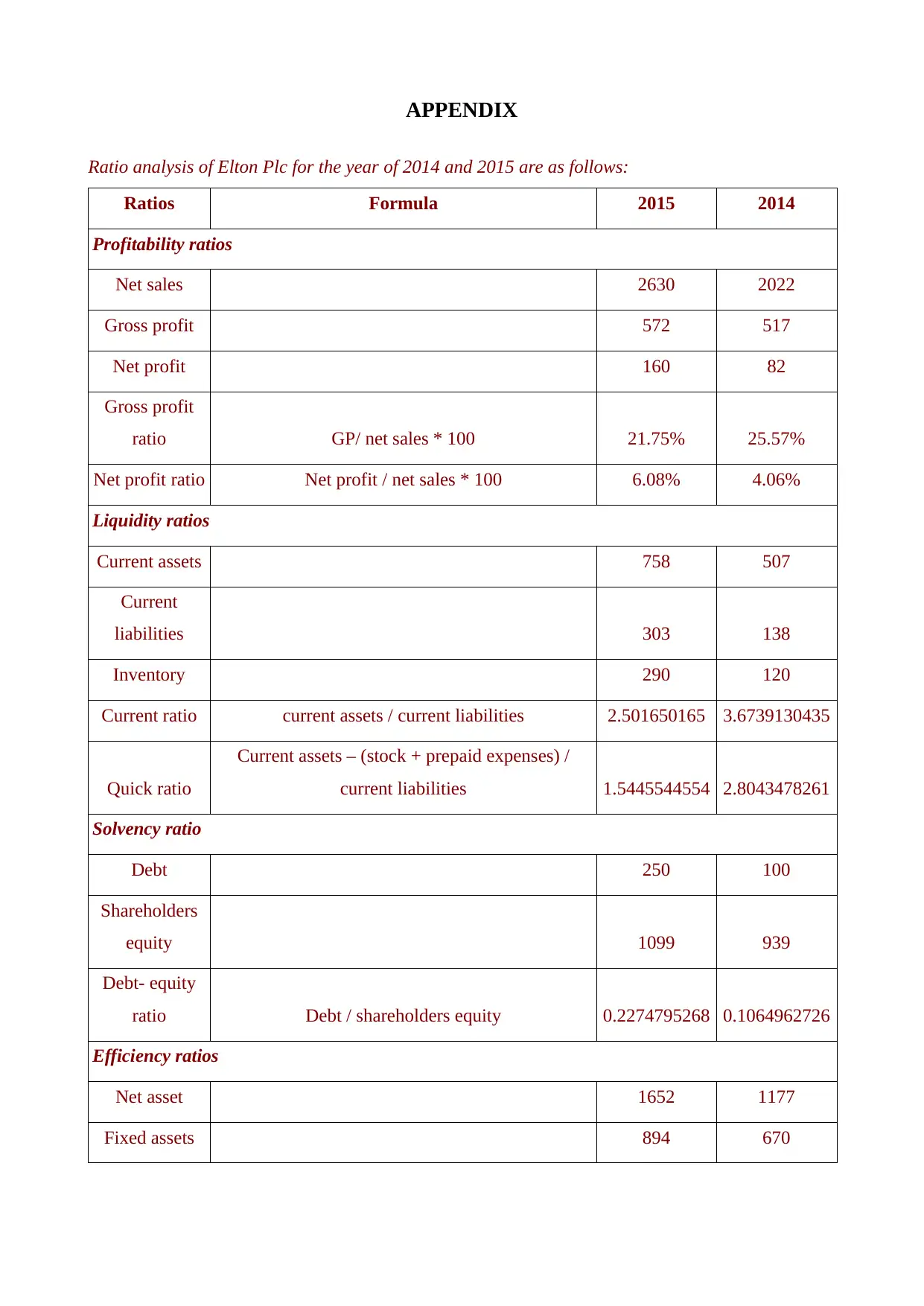
APPENDIX
Ratio analysis of Elton Plc for the year of 2014 and 2015 are as follows:
Ratios Formula 2015 2014
Profitability ratios
Net sales 2630 2022
Gross profit 572 517
Net profit 160 82
Gross profit
ratio GP/ net sales * 100 21.75% 25.57%
Net profit ratio Net profit / net sales * 100 6.08% 4.06%
Liquidity ratios
Current assets 758 507
Current
liabilities 303 138
Inventory 290 120
Current ratio current assets / current liabilities 2.501650165 3.6739130435
Quick ratio
Current assets – (stock + prepaid expenses) /
current liabilities 1.5445544554 2.8043478261
Solvency ratio
Debt 250 100
Shareholders
equity 1099 939
Debt- equity
ratio Debt / shareholders equity 0.2274795268 0.1064962726
Efficiency ratios
Net asset 1652 1177
Fixed assets 894 670
Ratio analysis of Elton Plc for the year of 2014 and 2015 are as follows:
Ratios Formula 2015 2014
Profitability ratios
Net sales 2630 2022
Gross profit 572 517
Net profit 160 82
Gross profit
ratio GP/ net sales * 100 21.75% 25.57%
Net profit ratio Net profit / net sales * 100 6.08% 4.06%
Liquidity ratios
Current assets 758 507
Current
liabilities 303 138
Inventory 290 120
Current ratio current assets / current liabilities 2.501650165 3.6739130435
Quick ratio
Current assets – (stock + prepaid expenses) /
current liabilities 1.5445544554 2.8043478261
Solvency ratio
Debt 250 100
Shareholders
equity 1099 939
Debt- equity
ratio Debt / shareholders equity 0.2274795268 0.1064962726
Efficiency ratios
Net asset 1652 1177
Fixed assets 894 670
Paraphrase This Document
Need a fresh take? Get an instant paraphrase of this document with our AI Paraphraser
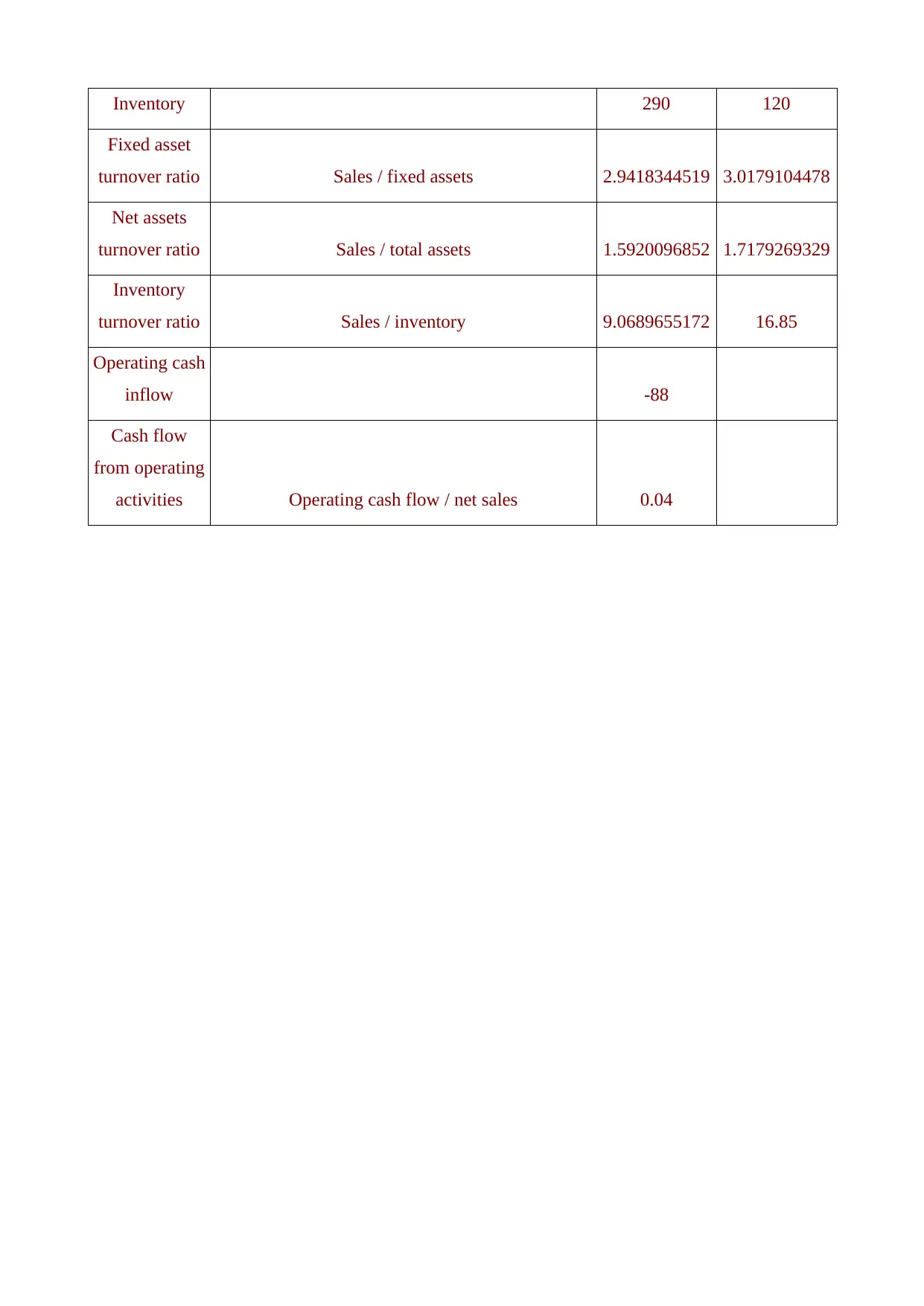
Inventory 290 120
Fixed asset
turnover ratio Sales / fixed assets 2.9418344519 3.0179104478
Net assets
turnover ratio Sales / total assets 1.5920096852 1.7179269329
Inventory
turnover ratio Sales / inventory 9.0689655172 16.85
Operating cash
inflow -88
Cash flow
from operating
activities Operating cash flow / net sales 0.04
Fixed asset
turnover ratio Sales / fixed assets 2.9418344519 3.0179104478
Net assets
turnover ratio Sales / total assets 1.5920096852 1.7179269329
Inventory
turnover ratio Sales / inventory 9.0689655172 16.85
Operating cash
inflow -88
Cash flow
from operating
activities Operating cash flow / net sales 0.04
1 out of 14
Related Documents
Your All-in-One AI-Powered Toolkit for Academic Success.
+13062052269
info@desklib.com
Available 24*7 on WhatsApp / Email
![[object Object]](/_next/static/media/star-bottom.7253800d.svg)
Unlock your academic potential
© 2024 | Zucol Services PVT LTD | All rights reserved.





